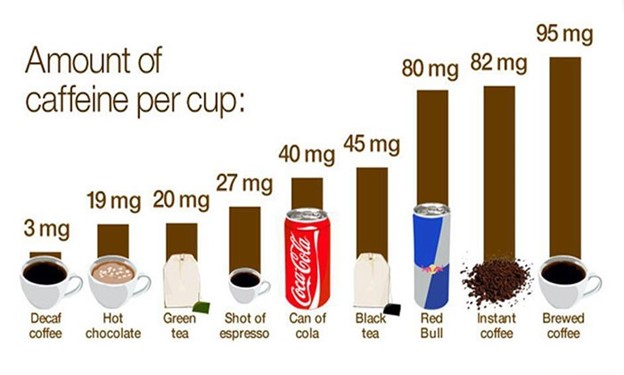- A nurse is reinforcing teaching with a client about reducing dietary caffeine intake. The nurse should remind the client that 240 mL (8 oz) of which of the following beverages contains the least amount of caffeine?
- Brewed green tea
- Hot cocoa
- Instant coffee
- Brewed green tea
- Hot cocoa
- Instant coffee
Cola soft drink
Brewed green tea
Hot cocoa
Instant coffee
Cola soft drink
The Correct Answer is B
Among the given options, 240 mL (8 oz) of hot cocoa typically contains the least amount of caffeine. While the exact caffeine content can vary depending on the brand and preparation method, hot cocoa is generally considered to have a lower caffeine content compared to brewed green tea, instant coffee, or cola soft drinks.
However, it's worth noting that hot cocoa may still contain a small amount of caffeine, although significantly less than the other options mentioned.

Nursing Test Bank
Naxlex Comprehensive Predictor Exams
Related Questions
Correct Answer is A
Explanation
Correct answer: A
Preschool-aged children (around 3 to 5 years old) have a limited understanding of death compared to older children or adults. They may not fully grasp the finality and permanence of death. They often have a more concrete and literal understanding of death.
A. Believing the death is punishment for bad behavior: Preschool-aged children (typically 3 to 5 years old) often have magical thinking and may believe that their thoughts or actions can cause events to happen. They may think that the death of a parent is a punishment for something they did or thought, reflecting their egocentric view of the world.
B. Recognizing the parent will never wake up: This understanding is more commonly seen in older children who have a more mature grasp of death. Preschool-aged children may not fully comprehend that death is irreversible and permanent.
C. While preschoolers might ask questions about the funeral out of curiosity, this is not the primary way they process or react to the death of a loved one. Their questions are often more about trying to understand what is happening rather than a genuine curiosity about the specifics of the service.
D. Understanding that everyone dies eventually: While preschool-aged children may have some understanding that death is a natural part of life, their comprehension of its full implications is limited. They may not fully grasp the universality of death and its inevitability for all living beings.
Correct Answer is D
Explanation
The nurse should intervene when the AP raises all four side-rails on the client's bed. While it is important to ensure the client's safety and minimize the risk of falls, raising all four side-rails can be considered a restraint and may not be the best practice for fall prevention. The use of physical restraints, including all four side-rails, can lead to adverse outcomes such as entrapment, increased agitation, and decreased mobility.
Locking the wheels on the client's bed: This is an appropriate action to prevent the bed from rolling and ensures stability.
Clearing furniture from the path leading to the bathroom: This is a good practice as it creates a clear and safe path for the client to walk without obstacles.
Assisting the client to the bathroom every 2 hours: This is a proactive measure to prevent falls by ensuring regular toileting and minimizing the need for the client to get up and move independently.
It's important to promote mobility and independence for the client while ensuring their safety.
Whether you are a student looking to ace your exams or a practicing nurse seeking to enhance your expertise , our nursing education contents will empower you with the confidence and competence to make a difference in the lives of patients and become a respected leader in the healthcare field.
Visit Naxlex, invest in your future and unlock endless possibilities with our unparalleled nursing education contents today
Report Wrong Answer on the Current Question
Do you disagree with the answer? If yes, what is your expected answer? Explain.
Kindly be descriptive with the issue you are facing.
